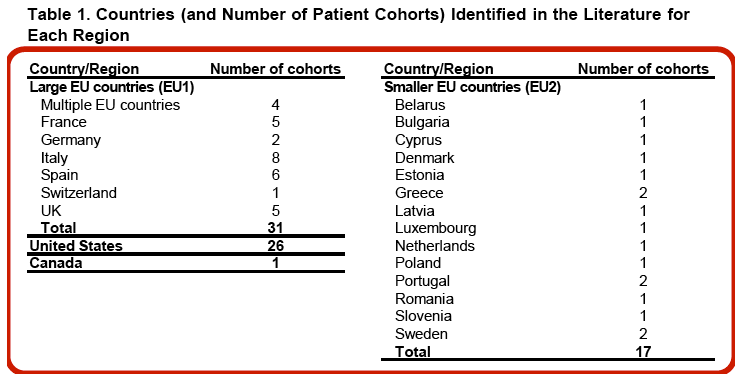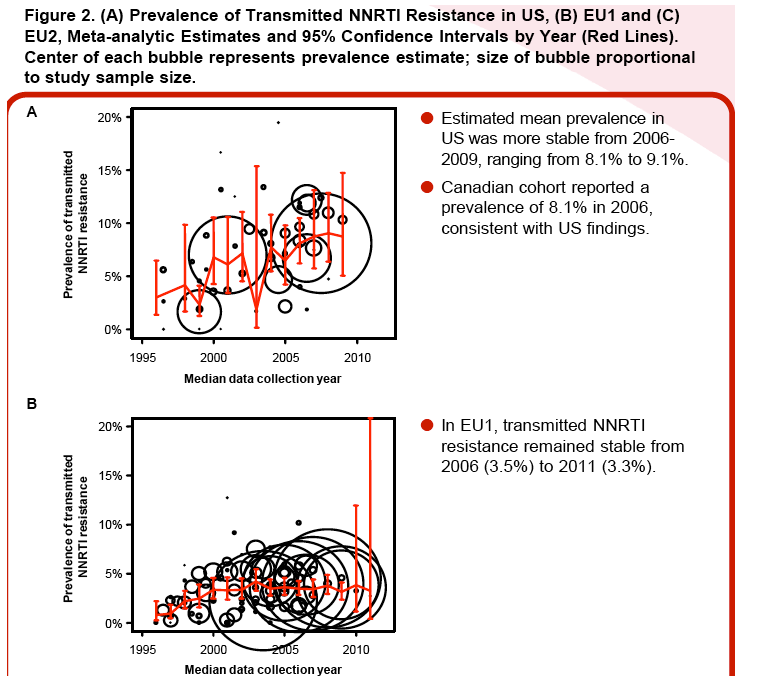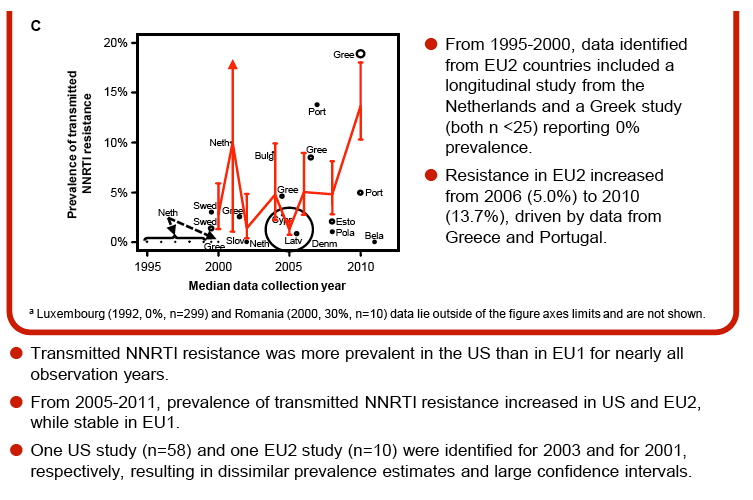 |
 |
 |
| |
Transmitted NNRTI Resistance Rate Climbing in US But Flat in Big European Countries
|
| |
| |
7th IAS Conference on HIV Pathogenesis, Treatment and Prevention, June 30-July 3, 2013, Kuala Lumpur
Mark Mascolini
Prevalence of transmitted nonnucleoside (NNRTI) resistance mutations rose in the United States and small European countries through recent years, according to an 84-study meta-analysis [1]. But transmitted NNRTI resistance prevalence plateaued at low levels in large European countries in recent years.
NNRTI resistance mutations emerge promptly upon failure of NNRTI regimens, which remain a cornerstone of first-line antiretroviral therapy across the world. Undetected NNRTI mutations in a recently infected person can imperil response to a first-line NNRTI regimen. A coalition of US researchers conducted this systematic review and meta-analysis to pinpoint prevalence and trace trends in transmitted NNRTI resistance in the United States, Europe, and Canada.
The investigators searched electronic databases for the years 2002 through 2012 and HIV conference reports for 2009 through 2012 to track down reports on NNRTI resistance prevalence. They focused on observational cohort studies involving antiretroviral-naive HIV-positive people at least 13 years old. The researchers considered four regions--the United States, Canada, large European Union countries (France, Germany, Italy, Spain, Switzerland, and the United Kingdom), and small European Union countries (all other EU countries). They used generalized linear mixed models to estimate prevalence of transmitted NNRTI resistance by weighting each study's contribution according to sample size.
The analysis included 84 observational studies representing 75 unique cohorts of antiretroviral-naive individuals. Data came from 61,800 cohort member samples tested in 22 countries over the years 1995-2011. There were 26 US cohorts, 31 large-country European cohorts, 17 small-country European cohorts, and one Canadian cohort.
From 1995 through 2000, transmitted NNRTI resistance prevalence rose in the United States and large European countries while remaining largely undetectable in small European countries. Transmitted NNRTI resistance proved more prevalent in the United States than in large European countries in nearly all study years.
From 2005 through 2011, transmitted NNRTI resistance prevalence continued to rise in the United States and began climbing in small European countries while remaining relatively stable in large European countries. From 2006 to 2009 in the United States, the rate seemed more stable, ranging from 8.1% to 9.1%. The sole Canadian cohort had a prevalence of 8.1% in 2006, similar to rates in the United States at that time.
In large European countries transmitted NNRTI resistance prevalence stayed low and flat from 2006 (3.5%) to 2011 (3.3%). The rate in small European countries jumped from 5.0% in 2006 to 13.7% in 2010, largely because of increases in Portugal and Greece, which had an outbreak of transmitted NNRTI resistance in injection drug users.
The researchers noted that second-generation NNRTIs did not become available until 2008, so most of the data they collected reflects resistance to efavirenz or nevirapine. Differences between regions in transmitted NNRTI resistance rates, they suggested, could reflect differences in treatment and prescribing practices, which this analysis did not consider.
"Because transmitted NNRTI resistance mutations can persist for years," the researchers observed, "small [and sometimes increasing] populations of patients will require long-term use of alternate therapies with resistance profiles distinct from those found with fist-generation NNRTIs."
Reference
1. Snedecor SJ, Sudharshan L, Nedrow K, et al. Burden of NNRTI resistance in treatment-naïve HIV-1-infected patients: a systematic review and meta-analysis. 7th IAS Conference on HIV Pathogenesis, Treatment and Prevention, June 30-July 3, 2013, Kuala Lumpur. Abstract TUPE288.
For the complete poster: http://pag.ias2013.org/EPosterHandler.axd?aid=2272








|
| |
|
 |
 |
|
|